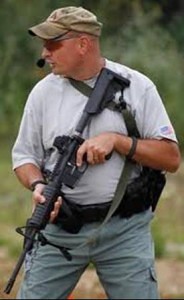By John Krupa III & John Farnam
At a recent Urban Rifle Course held at an outdoor range, a student with the muzzle of her AR (patrol rifle) elevated had a ND (negligent discharge), which put a single 5.56 x 45 bullet over the berm and off-property. The bullet in question subsequently impacted, at a high angle, a lake a half-mile downrange. No injury or property was damaged as a result, but several local fishermen reported the incident to the local sheriff’s office, and I heard about it shortly thereafter.
Berm heights vary widely from range to range. Most are 10 feet or higher. Even so, sending a bullet over the berm is still easily done, no matter the height. Some fancy ranges even have downrange, overhead “baffles” designed to keep bullets–inadvertently launched at a high angle–from leaving the range; however, even at these facilities, bullets occasionally seem to find a way off-property. Additional efforts to contain them invariably convert the “outdoor range” into an indoor range!
The better solution to this issue is muzzle-discipline.
“Muzzle-Down” is the by-word on all DTI (Defensive Training Institute) Ranges. All rifle, pistol, and shotgun handling is with the muzzle no higher than horizontal. Elevating muzzles past horizontal during administrative processes, and during reloading and stoppage-reduction, is commonly taught in some quarters, but it is wrong and dangerous!
In the incident described above, a rifle muzzle was inadvertently elevated during the loading process, as the student was relying on previous training. We corrected it, of course, but not before that single round departed range property.
When ND’s occur with the muzzle down and angled toward the berm, the bullet hits the ground between the shooter and the berm and can still subsequently jump over to the other side. However, these ricochets are typically low energy and far less dangerous than direct launches. “Muzzle-Up” is bad practice for other reasons too. Handling guns with the muzzle up is an invitation to a disarm, and rifle barrels angled upward will reliably betray an operator’s position and intentions, particularly when he/she is behind cover.
So, our students need to become accustomed to keeping all muzzles continually at a downward angle, coming up to horizontal only when aiming at a target. All administrative processes-loading, unloading, and performing a chamber-check can be (and must be) done with the operator facing in a relatively safe direction with the muzzle angled downward.
With escalating numbers of novice gun owners, preventing gun accidents is rapidly emerging as a critical priority. Gun-fear, trigger-locks, and the “empty-gun/never-ready” philosophy represent only a false and fraudulent myth. Genuine Operators, who carry and deal with loaded guns every day, need a legitimate and dependable gun-handling procedure that is adhered to without fail, and keeping muzzles down is an integral component.
About John Krupa III
John is a police officer with the Orland Hills Police Dept. and has over 20 years of experience in LE. He has previously served as a beat officer, rapid response officer, and firearms instructor with Chicago PD. He is a graduate firearms instructor from the Secret Service Academy, FBI, DEA, and FLETC. John is founder and president of Spartan Tactical Training Group, Director of Training for the DS Arms LE Training Division, and has previously presented at ASLET, GTOA, IALEFI, ILEETA, ISOA, LETC, MTOA, NTOA, and TTPOA training conferences. To learn more about John Krupa III or Spartan Tactical Training Group, click here.
About John Farnam
John has been a police officer since 1971, when he joined the City of Elroy Police Department as a patrolman. He is presently a fully commissioned deputy sheriff Training Officer for the Park County, Colorado Sheriff’s Office. John has written articles about defensive shooting and tactics in addition to several books. To learn more about John Farnam or Defensive Training Institute (DTI), click here.
* The views are the authors’ own and don’t necessarily represent those of Action Target, Inc.







I understand the concern and the firearms training that I conduct for the security officers at my company requires the same muzzle down mandate. That being said, I recently attended a intermediate carbine course with Trident Concepts that introduced me to the high ready position. This ready position has the muzzle held up at about eye level or 20 to 30 degrees depending on the preference and size of the operator. I had not had much training with this position with a rifle and it felt funny at first to hold it that way. Likewise, during reloads and stoppage clearances, the rifle was brought into this high ready eyes up to the threat work space. All students were encouraged to practice this ready position, along with the traditional low ready and retention ready (buttstock tucked under the armpit). I used all three equally over the three day course, but found that the high ready was faster and more intuitive. Additionally, I conducted reloads more efficiently and cleared stoppages faster while fatigued. My point is that the operator needs options that allow flexibility. I know and work with the safety concerns live fire poses, but I have an issue with removing a useful tool in the name of range safety. Muzzle down is not always the safest direction; students will revert to what they practice under stress. I am curious to know your or anyone else’s thoughts. I enjoy the dialogue.